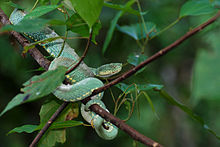- Bothriopsis bilineata
-
Bothriopsis bilineata 
Scientific classification Kingdom: Animalia Phylum: Chordata Subphylum: Vertebrata Class: Reptilia Order: Squamata Suborder: Serpentes Family: Viperidae Subfamily: Crotalinae Genus: Bothriopsis Species: B. bilineata Binomial name Bothriopsis bilineata
(Wied-Neuwied, 1821)Synonyms - Cophias bilineatus - Wied-Neuwied, 1821
- Trigonoceph[alus]. bilineatus - Schinz, 1822
- [Bothrops] bilineatus - Wagler, 1830
- T[rigonocephalus]. bilineatus - Schlegel, 1837
- Craspedocephalus bilineatus - Gray, 1849
- Bothrops bilineatus - Duméril, Bibron & Duméril, 1954
- Trigonocephalus (Bothrops) arboreus - Cope, 1870
- Lachesis bilineatus - Boulenger, 1896
- Lachesis bilineata - Boettger, 1898
- Bothrops bilineata - Amaral, 1930
- Bothrops bilineatus bilineatus - Hoge, 1966
- Bothriopsis bilineata bilineata - Campbell & Lamar, 1989
- Bothriechis bilineatus bilineatus - Golay et al., 1993[1]
Bothriopsis bilineata is a venomous pitviper species found in the Amazon region of South America. A pale green arboreal species that may reach a meter in length, it is an important cause of snakebite throughout the entire Amazon region. Two subspecies are currently recognized, including the nominate subspecies described here.[5]
Contents
Description
Adults usually do not grow to more than 70 cm in length, although some may reach 100 cm. The maximum reported size is 123 cm. The body is relatively slender with a prehensile tail.[2]
The scalation includes 23-35 dorsal scales ant midbody, 190-218/192-220 ventral scales in males/females and 65-76/55-73 mostly divided subcaudal scales in males/females. On the head there are 5-9 keeled intersupraoculars, 8-12 sublabial scales and 7-9 supralabial scales. Of the latter, the second is usually fused with the prelacunal to form a lacunolabial, although partial or complete sutures may exist to separate these scales.[2]
The color pattern consists of a pale green ground color that is overlaid dorsally with either a peppering of black spots, or a series of tan or reddish brown spots that are usually paired. The ventrals are bordered by a creamy yellow line running down the length of the body, while the belly itself is yellow and bordered with a tinge of green. The latter part of the tail is pink and bordered with yellow. The head is either green with a scattering of small black spots, or green with isolated tan or reddish brown spots that are bordered in black. The iris is pale green while the labials are yellow green, often with black spots.[2]
The nominate subspecies, B. b. bilineata, has vertical dark stripes on the supralabial scales and a dorsal pattern of reddish brown spots with black flecks.[2]
Geographic range
Found in the Amazon region of South America: Colombia, Venezuela, Guyana, Surinam, French Guiana, Brazil, Ecuador, Peru and Bolivia. An isolated population is known from the Atlantic versant of southeastern Brazil. The type locality given is "Brasilien."[1]
Habitat
Lowland rain forest, in shrubbery, palms and trees, especially in the vicinity of water.[2][4] Soini (1974) states that it is almost always found in bushes and trees along streams or along the edges for forest clearings. Mostly associated with primary forest, although is also been found in older secondary forest near primary forest.[2]
Behavior
Nocturnal, this species spends the day hidden in thick foliage, tree hollows or at the base of palm fronds, and always in places where it can anchor itself with its prehensile tail. They tend to rely on ambush instead of actively hunting for prey.[4]
Feeding
The diet consis of small mammals, such as mouse opossums (Marmosa), mice, birds, lizards and frogs. Juveniles tend to remain closer to the ground to feed on small frogs and lizards.[4]
Reproduction
Ovoviviparous, with females giving birth to live young.[4]
Venom
This species is an important cause of snakebite throughout the entire amazon region. Due to its arboreal nature, most bites are to the upper body, including hands, arms and face.[3]
Clinical features include bruising, profound coagulopathy and spontaneous bleeding. Symptoms reported from various case histories include local pain, swelling, bruising, bleeding of the gums, loss of consciousness, hematemesis, hematuria, fever, erythema, bleeding from the fang punctures, shock, bleeding from the mouth, nose and eyes, nausea, and incoagulable blood. At least one death has been reported.[3]
Subspecies
Subspecies[5] Taxon author[5] Common name Geographic range[2] B. b. bilineata (Wied-Neuwied, 1821) Amazonian palm viper[4] South America in the equatorial forests of Venezuela, Guyana, Suriname, French Guiana and Brazil, including the Atlantic Forest. B. b. smaragdinus (Hoge, 1966) Loro machaco (Peru) South America in the Amazon regions of Colombia, southern Venezuela, northern and western Brazil, Ecuador, Peru and Bolivia. If these subspecies are eventually proved to be monophyletic, then this will suggest that the Amazon Rainforest split into eastern and western parts before the eastern part split from the more southern Atlantic Forest.[2]
See also
- List of crotaline species and subspecies
- Crotalinae by common name
- Crotalinae by taxonomic synonyms
- Snakebite
References
- ^ a b McDiarmid RW, Campbell JA, Touré T. 1999. Snake Species of the World: A Taxonomic and Geographic Reference, vol. 1. Herpetologists' League. 511 pp. ISBN 1-893777-00-6 (series). ISBN 1-893777-01-4 (volume).
- ^ a b c d e f g h i Campbell JA, Lamar WW. 2004. The Venomous Reptiles of the Western Hemisphere. 2 volumes. Comstock Publishing Associates, Ithaca and London. 870 pp. 1500 plates. ISBN 0-8014-4141-2.
- ^ a b c Warrell DA. 2004. Snakebites in Central and South America: Epidemiology, Clinical Features, and Clinical Management. In Campbell JA, Lamar WW. 2004. The Venomous Reptiles of the Western Hemisphere. Comstock Publishing Associates, Ithaca and London. 870 pp. 1500 plates. ISBN 0-8014-4141-2.
- ^ a b c d e f Mehrtens JM. 1987. Living Snakes of the World in Color. New York: Sterling Publishers. 480 pp. ISBN 0-8069-6460-X.
- ^ a b c "Bothriopsis bilineata". Integrated Taxonomic Information System. http://www.itis.gov/servlet/SingleRpt/SingleRpt?search_topic=TSN&search_value=634844. Retrieved 27 July 2008.
External links
- Bothriopsis bilineata at the Reptarium.cz Reptile Database. Accessed 27 July 2008.
Categories:
Wikimedia Foundation. 2010.
